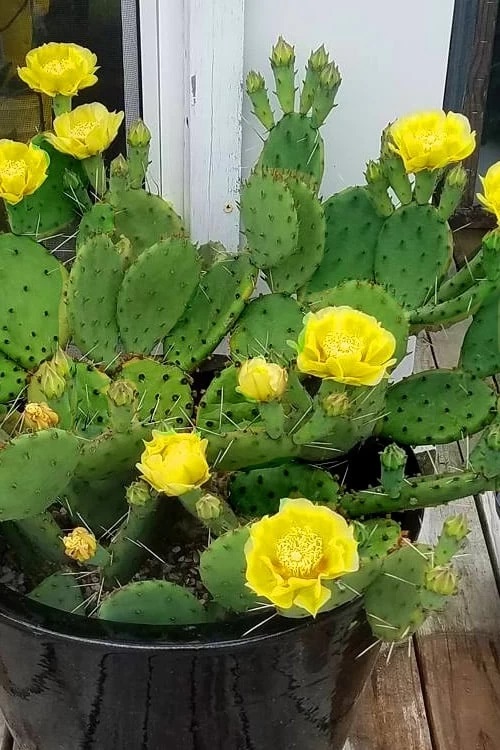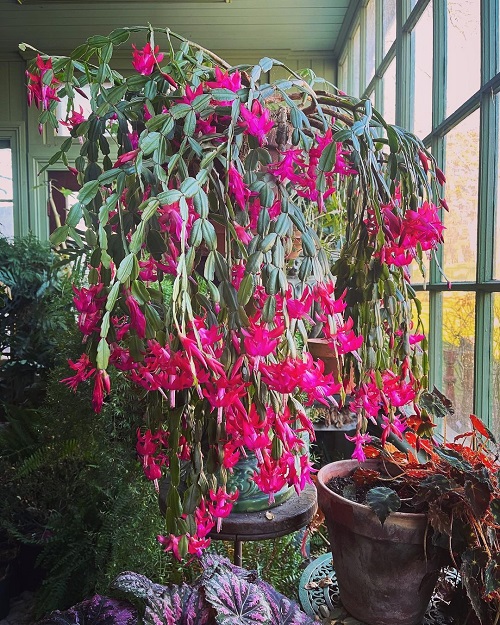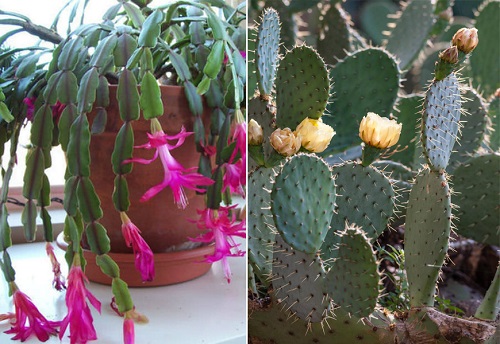Read this article about Prickly Pear Cactus Vs. Christmas Cactus to know what sets them apart and which variety will be your favorite pick.
Although their look is an easy difference to catch which cactus is which. But, to clear up all small confusions and get to know these plants closely, have a look at the major differences between Prickly Pear and Christmas Cactus in detail below!
How to Recognize a Prickly Pear Cactus

The Prickly Pear Cactus is a flat-stemmed spiny cactus from the Opuntia genus and is known for its edible fruits. You can recognize it by its broad stems, which are covered with barbed hairs known as glochids. This cactus blooms with yellow flowers between May and June, and red fruits will emerge on its flat stems from the beginning of July.
Caution: Wear gloves when handling Prickly Pear to avoid getting poked by its tiny glochids!
How to Identify a Christmas Cactus

The Christmas cactus has flattened stems and is recognized by cerise flowers blooming between November and January. You may end up confusing it with the Thanksgiving cactus. However, Christmas cactus has leaves that aren’t as pointed—instead, they’re more rounded with a scalloped edge, kind of like a teardrop shape.
Difference Between Prickly Pear Cactus and Christmas Cactus

1. Appearance
As mentioned, the Prickly Pear Cactus has flat, paddle-like stems covered by tiny, hair-like barbed spines. The Christmas Cactus also has flattened stems, but these are segmented and do not have spines. When we compare the two in appearance, you will find that the Prickly Pear has much broader and thicker stems than its counterpart.
2. Growth Habit
Prickly Pear Cactus grows upright and can reach up to 20 feet in height. This plant also has a significant spread, forming clumps that can spread over 10 feet. On the other hand, the Christmas Cactus has trailing or arching growth, which is why gardeners love growing it as a hanging plant. A mature Christmas cactus can grow one foot in height and can spread up to 2 feet on average.
3. Flowering Time
The flowering time of both these plants is something that sets them apart from each other. Prickly Pear Cactus blooms in late spring to early summer with large yellow, orange, or red flowers. Christmas Cactus is the winter bloomer that grows around the time of the Christmas season (November to January).
Here is a small tip to encourage more blooms on your Christmas Cactus, place it in a cool, dark place for about 12-14 hours daily for five to six weeks before the holiday season.
4. Temperature and Watering Needs
Prickly Pear Cactus thrives in hot and arid climates and you can easily subject it to heat and direct sunlight. The same is not true for Christmas Cactus, as it prefers cooler and more humid environments. Unlike Prickly Pear, this one is sensitive to extreme temperatures and prefers indirect light.
Your Prickly Pear Cactus requires minimal watering due to its drought-tolerant character. However, you must be more careful with the watering needs of Christmas Cactus especially during its growing season, as it needs frequent watering like once in a week or when you feel that soil is getting dry completely.
5. Propagation Method
Prickly Pear Cactus propagates easily through its broad, flat pads. You just have to detach these pads and plant them directly in the soil. On the other hand, Christmas Cactus propagates through stem cuttings. You can cut a segment of its stem and allow it to root in a moist potting mix.
So, here you have the main differences between Prickly Pear and Christmas Cactus. Hope you can easily identify them when you look at them next time. People often confuse Thanksgiving Cactus and Christmas Cactus, but you won’t go into that dilemma after reading our detailed article on these two cacti, too. Check it out and don’t forget to share your experiences in the comments.







